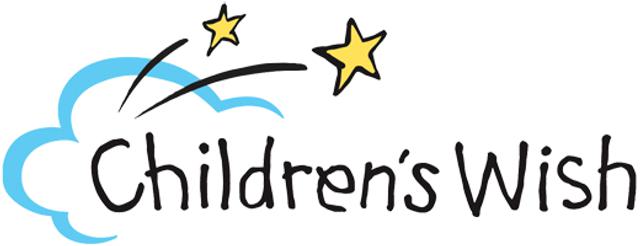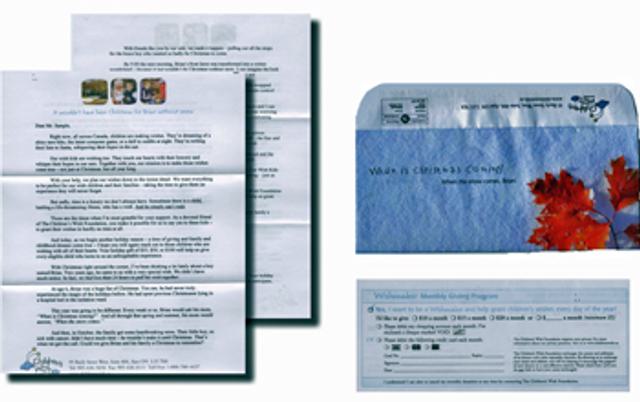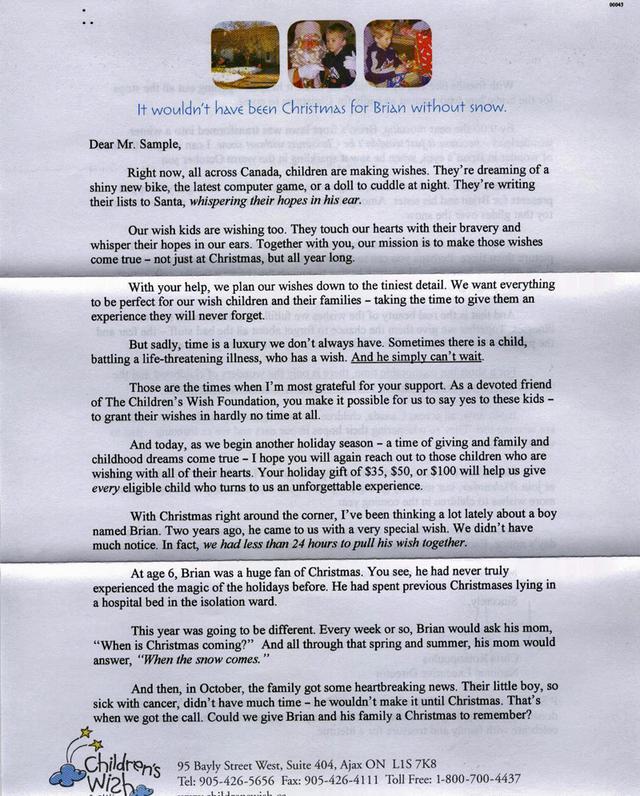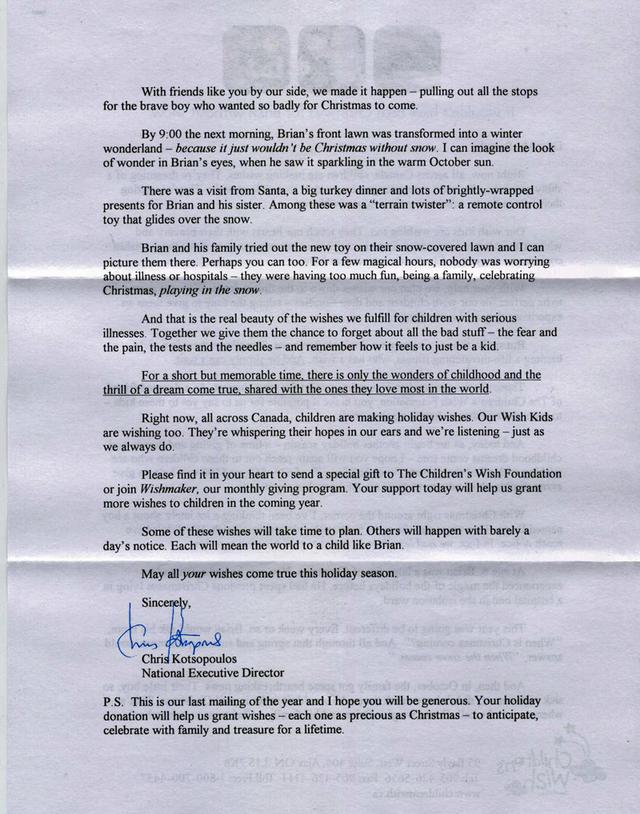Children’s Wish Foundation: the power of a story
- Exhibited by
- Liz Attfield, Stephen Thomas Ltd.
- Added
- August 18, 2009
- Medium of Communication
- Direct mail.
- Target Audience
- Individuals.
- Type of Charity
- Children, youth and family.
- Country of Origin
- Canada.
- Date of first appearance
- November, 2007.
SOFII’s view
All nonprofits need to tell stories. Through storytelling you will build deeper connections with your supporters and, ultimately, raise more money for your cause. In this appeal mailing the Children’s Wish Foundation makes a dying boy’s wish to experience Christmas come true. It’s a sad but moving and appealing story, perhaps the best possible reason for bringing forward the traditional Christmas appeal.
We at SOFII challenge all nonprofits to develop strong and emotional stories to tell others about the great work they do. It’s the power of storytelling.
Creator / originator
Children’s Wish Foundation and Stephen Thomas Ltd, Canada
Summary / objectives
The main objective was donor renewal – that is seeking an additional gift from our current supporter base. There were many first-time donors on the Foundation’s file, and we wanted to ensure as many as possible would give that all-important second gift.
A secondary objective was to increase the level of donor stewardship and build stronger relationships with donors who were new to the organisation, or who had traditionally supported the organisation through events. It was important for these supporters to find out more about how the Children’s Wish Foundation uses public donations to give sick children the joy of having their wish come true.
Background
The Children’s Wish Foundation of Canada was established 25 years ago. For the first 20 years, much of their fundraising was as a result of third-party events. For instance, people in the community would run events – barbecues, morning teas, fun runs, and so on – and then donate the money they had raised to the Children’s Wish Foundation.
Our agency began working with the Foundation in 2006. At the time they had about 4,000 donors on file. We worked to grow their existing supporter base, as well as acquiring new supporters.
In 2006, we undertook a few mail campaigns. However, it was in 2007 that we worked on the full communications cycle. This pack was an important part of that cycle.
Special characteristics
The Children’s Wish Foundation grants over 1,000 wishes each year and one of the great things about the Foundation is the wonderful and inspiring stories they have to tell. Often they are very sad stories; when we heard about six-year-old Brian, who had been very ill and died not long after his wish was granted, we knew it was the right story for this appeal.
Brian would constantly ask his mum when Christmas would come. His mum’s answer was that Christmas would come when it snows. Then in October, the family got the news that Brian didn’t have much time left and that he wouldn’t live to see Christmas. That’s when they called the Children’s Wish Foundation.
In less than 24 hours, the Foundation had organised a snow-making machine, a visit from Santa, a turkey dinner and presents, lots of presents. Brian and his family had their Christmas in October. Sadly, Brian died soon afterwards. But his wish had come true.
With the Children’s Wish Foundation, we’re never at a loss for stories to tell. And this was a particularly special one.
Details
We tested two types of letters – the control letter was from the CEO of the Foundation; the other letter was written by the 'wish' co-ordinator. We thought that this second letter would result in a higher response rate and average gift, because it was more direct and more emotional.
However, while this letter did get a slightly higher response rate (9.95 per cent), the average gift was lower than the control pack. The control pack resulted in a slightly smaller response rate (9.88 per cent) and a higher average gift. This resulted in better net income for the charity.
Nevertheless, the variation in the results was not statistically valid, due to the very small margin of difference in response rates and average gift. It was an interesting test, all the same.
Costs
Approximately $CAN 29,000
Results
The campaign exceeded budget. We mailed 22,000 donors, many of whom had made their first gift to the organisation in the preceding 12 months.
The response from longer-term donors was 16.25 per cent. Eight per cent of donors who had previously made only one gift gave in response to this mailing. We exceeded net revenue targets by 44 per cent, achieving an overall net income of $CAN 50,000.
Merits
It’s such a simple pack that focuses on the basics, particularly good storytelling. Unlike many mailings that are sent in Canada, it did not include premiums, such as address labels or other gifts to entice a donation. It is just about a dying boy, wanting to experience his favourite thing in life – Christmas – and the nonprofit organisation that, with the help of its donors, made his wish come true.
The story is one we can all relate to. We sometimes lose track of things that really matter and for this boy it was Christmas time. As parents, grandparents, sisters and brothers, we can imagine the sadness of the family knowing that this boy wouldn’t make it to see his next Christmas. But thanks to the generosity of donors and the Children’s Wish Foundation, there were presents, a turkey dinner and snow on a sunny October day.
Other relevant information
One of the things we have learned from previous appeals is that the Foundation’s packs perform better when they focus on just one story. This allows us to get the emotion across. It means that we can deepen the story by painting the picture of these children who are constantly in and out of the hospital. While they adapt to their illness, they miss out on the fun things in life. And the families do too. It’s also good if we can include the bigger story of the family’s role in the granting of a wish.
 View original image
View original image


 View original image
View original image
 View original image
View original image
Also in Categories
-
- Communications toolbox

















